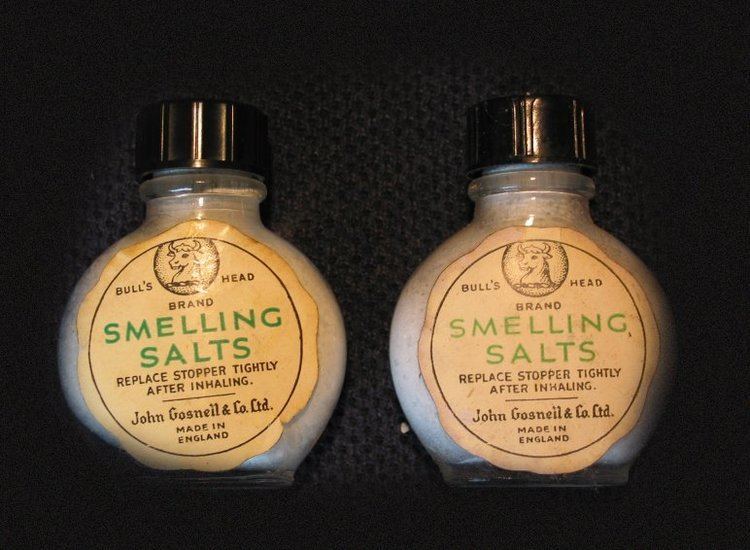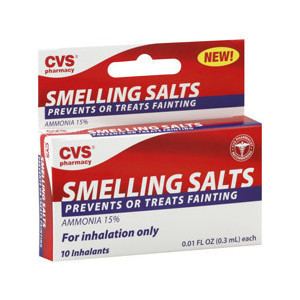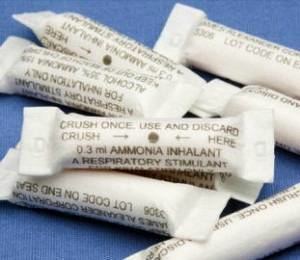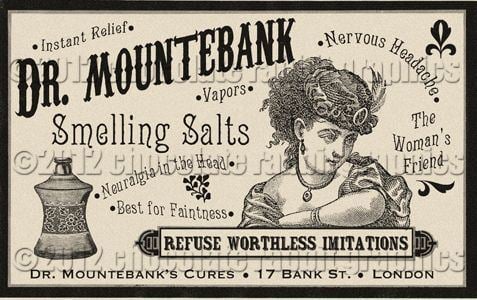 | ||
Beer leaguers try smelling salts
Smelling salts, also known as ammonia inhalants, spirit of hartshorn or sal volatile, are chemical compounds often used to arouse consciousness. High-quality scientific studies of smelling salts are almost non-existent and as a result, many consider them to be ineffective.
Contents
- Beer leaguers try smelling salts
- Smelling salts yay or nay
- Usage
- History
- Physiological action
- Risks
- In popular culture
- References

Smelling salts yay or nay
Usage

The usual active compound is ammonium carbonate—a colorless-to-white, crystalline solid ((NH4)2CO3). Because most modern solutions are mixed with water, they should more properly be called "aromatic spirits of ammonia." Modern solutions may also contain other products to perfume or act in conjunction with the ammonia, such as lavender oil or eucalyptus oil.

Historically, smelling salts have been used on people feeling faint, or who have fainted. They are usually administered by others, but may be self-administered; some at-risk groups, such as pregnant women, may be advised to keep them close to hand.

Smelling salts are often used on athletes (particularly boxers) who have been dazed or knocked unconscious to restore consciousness and mental alertness. Smelling salts are now banned in most boxing competitions, but are not harmful.

They are also used as a form of stimulant in athletic competitions (such as powerlifting, strong man and ice hockey) to "wake up" competitors to perform better. In 2005, Michael Strahan estimated that 70 to 80 percent of National Football League players were using smelling salts as stimulants.
History
Smelling salts have been used since Roman times and are mentioned in the writings of Pliny as Hammoniacus sal. Evidence exists of use in the 13th century by alchemists as sal ammoniac. In the 14th century's The Canterbury Tales, a character purports to use sal armonyak. In the 17th century, the distillation of an ammonia solution from shavings of harts' (deer) horns and hooves led to the alternative name for smelling salts as spirit or salt of hartshorn.
They were widely used in Victorian Britain to revive fainting women, and in some areas constables would carry a container of them for the purpose. During this time, smelling salts were commonly dissolved with perfume in vinegar or alcohol and soaked onto a sponge, which was then carried on the person in a decorative container called a vinaigrette.
The use of smelling salts was widely recommended during the Second World War, with all workplaces advised by the British Red Cross and St. John Ambulance to keep smelling salts in their first aid boxes.
Physiological action
Smelling salts release ammonia (NH3) gas, which triggers an inhalation reflex (that is, causes the muscles that control breathing to work faster) by irritating the mucous membranes of the nose and lungs. Although these hypothetical mechanisms have been discussed, it is likely that smelling salts are not effective.
Fainting can be caused by excessive parasympathetic and vagal activity that slows the heart, and decreases perfusion of the brain. The sympathetic irritant effect is exploited to counteract these vagal parasympathetic effects and thereby reverse the faint.
Risks
Ammonia gas is toxic in large concentrations for prolonged periods and can be fatal. Since smelling salts produce only a small amount of ammonia gas, no adverse health problems from their situational use have been reported. However, a high concentration of inhaled ammonia might burn the nasal or oral mucosa.
The use of ammonia smelling salts to revive people injured during sport is not recommended because it may inhibit or delay a proper and thorough neurological assessment by a healthcare professional, such as after concussions when hospitalization may be advisable, and some governing bodies recommend specifically against it. The irritant nature of smelling salts means that they can exacerbate any pre-existing cervical spine injury by causing reflex withdrawal away from them.
In popular culture
In Through the Looking Glass, when the White King eats hay because he feels faint, Alice says that sal-volatile would be better.
In Hard Times by Charles Dickens, Mr. Bounderby buys smelling salts as a precaution in case people will need to be revived after he announces his wedding engagement.
Aunt Pittypat in the novel Gone With The Wind, portrayed as a foolish old woman, frequently needs to use smelling salts when confronted with exciting or distressing events.
Milburn Drysdale from The Beverly Hillbillies used a stack of money in a similar manner as smelling salts.
In the television show Dexter, the main character uses smelling salts to awaken victims he has knocked unconscious with M99.
In the Final Fantasy games, there is an item named Smelling Salts, which cures Confusion.
In the Macdonald Hall books by Gordon Korman, Miss Scrimmage, the headmistress of a young lady's finishing school, frequently faints, and her students revive her with smelling salts.
In the 2015 film The Gunman, Sean Penn plays a character who uses ammonia inhalants as he is pursued by armed vigilantes in order to regain some level of alertness. The scene shows him breaking open a small container and directly inhaling the substance into one of his nostrils.
